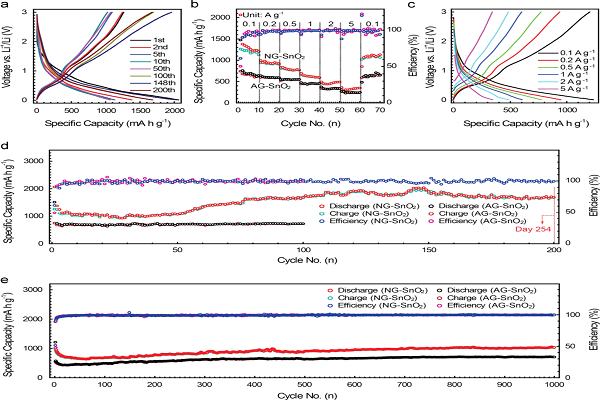A research team led by Professor Cong Huaiping, from School of Chemistry and Chemical Engineering, HFUT worked out a balanced design of graphene–SnO2 composite, i.e., a flexible nitrogen-doped graphene/ SnO2 (NG–SnO2) foam with an integrated macro scale film and interconnected micro-/nano-foam architecture.
The combined favorable structure and components improve the Li+ accessibility and electron transmission, while prevent side reactions with the electrolyte and SnO2. Notably, a novel electrochemistry is triggered by the synergistic effect between SnO2 and graphene, i.e., irreversible conversion reaction of SnO2 becomes reversible upon cycling. These efforts lead to an ascending capacity with the increment of 41000 mAhg_1. The composite foam can retain more than 81% of its initial capacity to 1678mA hg_1 over cycles of 8.5 months at a rate of 0.1 Ag_1, exhibiting kinetically-stable electrochemical performances.
The study was published on Nano Energy of Elsevier (Nano Energy 2015, 13, 482-490)
Recently, the team developed a thermo responsive poly (N -isopropylacrylamide)/ graphene/Au nanocomposite hydrogel for water treatment by a laser-assisted approach. Assisted by near-infrared (NIR) laser, the temperature of the hydrogel rises because of the strong photothermal energy conversion ability of grapheme, demonstrating its capability reduction of MB from a blue color in its oxidized state (MB) into colorless in its reduced state. The study was published by Small of Wiley (Small, 2015, 11(9-10), 1165-1170).
Owing to the rich experience in Graphene-based macroscopic assemblies and architectures, the team was invited by Chemical Society Reviews to contribute a review article titled Graphene-based macroscopic assemblies and architectures: an emerging material system.
This critical review mainly addresses recent advances in the design and fabrication of graphene-based macroscopic assemblies and architectures and their potential applications in the fields of electronic and optoelectronic devices, sensors, electrochemical energy devices, and in water treatment.
The above-mentioned researches were supported by National Natural Science Foundation of China, Program for New Century Excellent Talents in University and HFUT funds.

Figure 1. Battery performance of NG–SnO2 foam andAG–SnO2 paper


 HOME
/
Content
HOME
/
Content
